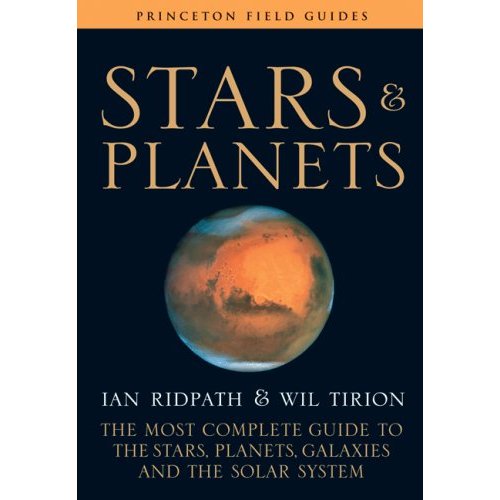Ian Ridpath has been adding to his impressive list of publications with the recently updated fourth edition of “Stars and Planets“. Or, consider its more accurate and complete title “Princeton Field Guides Stars & Planets – The Most Complete Guide to the Stars, Planets, Galaxies and the Solar System“. The title’s quite a mouthful, but the book lives up to the billing. Within it, Ian Ridpath’s texts and Wil Tirion’s illustrations cover all that would interest an active, backyard astronomer.
Being the fourth edition, this review should assess changes from the book’s predecessor. Lacking the third edition means I’m considering the book in isolation.
This book has two parts. The first includes star charts; four per month, with the northern latitude facing south and then north and the same for the southern latitude. The charts show about 5000 separate stars, all being a white dot on a pale blue background with black lettering. After this inclusion, there’s notes on each of the 88 constellations. Again, star charts accompany each. To further entice the reader, nearly each constellation description has a wonderful, colour photograph of a particularly rewarding view, usually as seen from the National Optical Astronomy Observatory (NOAO) in Arizona.
However, as much as the NOAO facility is for the big league, this book stays true to being a guide for the amateur. As such, nearly all comments on viewing, and there are many, relate to either binoculars or small to mid-size home telescopes.
The second part of the book starts off with a look into the life cycle of stars and the particular and useful intricacies of the electromagnetic spectrum. Then, it proceeds to describe viewing pleasures on a planet by planet meander through our solar system. Further, twelve full page maps completely identify features shown on the Moon’s near side. Again, the perspective is for that of a person using amateur level equipment. To help the reader along, the book concludes with a short discussion on choosing binoculars and telescopes.
Being a field guide, this book is of smaller stature than most. Yet, it still won’t fit easily into most pant pockets. However, it would be a great asset to have on hand when deciding how to coordinate a star party or optimize personal evening viewing. And, though not stated in the title, it is for observers, so there’s not a great depth of detail on why or what-for. Thus, for observers, it is of a just the right stature.
Though I’m not in a position to assess the title’s proclamation of being the most complete guide, I will say that it is the best one that I’ve read. With Ian Ridpath’s text and Wil Tirion’s illustrations, the “Princeton Field Guides Stars & Planets” is a wonderful guide to the stars, planets, galaxies and our own solar system. It will help in getting that illusive target into the finder and onto the eagerly awaiting eye.


Mike,
spelling error in the last paragraph…asses instead of assess. Not normally one to point it out, but it does make the article look a little less professional.
I might add great book by the way, I bought my copy earlier today
and my apologies with the name error, Mark
I notice you mention that it explores the planets of our solar system – are the planets of other systems mentioned?
If not, are there any books out there which have detailed listings of extrasolar planets?
I know there are web pages with all the details but it would be nice to have a book I could stick on my coffee table with the locations, names, and orbital details of all the extrasolar planets.